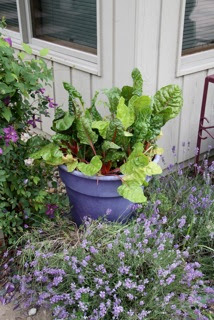 |
| 'Bright Lights' Swiss Chard in resin pot |
There’s still plenty of time to plant two delicious greens--Swiss chard (Beta vulgaris) and Bok Choy (Brassica rapa)--for a prolonged harvest. Both are easy-to-grow, nutritious veggies that do very well in cool weather. Gardeners often sow them in the early spring and again in July and August for a fall harvest.
Whether you sow them now from seeds, or buy transplants from your local garden center, Swiss chard and Bok choy should be planted in fertile, evenly moist soil that receives full sun.
“Bok choy is one of the easiest and fastest vegetables to grow,” says Renee Shepherd, owner of Renee’s Garden (www.reneesgarden.com), a mail-order seed company. “It grows well in cool spring weather and you can also definitely plant another crop again at the end of the summer for late fall harvest.”
Bok choy (aka Bok choi, Pak choy or Pac choi) is a vigorous, fast-growing Asian green that provides a good source of calcium, fiber and vitamins A and C. Plants tend to be vase-shaped with thick white stalks. In fact, the name means “white vegetable” in Chinese. The flavor might best be described as tangy-sweet yet delicate. It can be used in stir-fries or as baby salad greens when the plants are 2 to 3 inches tall.
When sowing Bok choy seeds, plant them about 1/4 inch deep and 2 inches apart. Seeds sprout in about 5 to 7 days and harvesting begins in about 35 days. “Bok choy just needs fertile, well-drained soil and it's important to thin the young seedlings to stand about 5 to 6 inches apart so they have room to make pretty vase-shaped plants of crunchy pastel green stalks and deep green leaves,” Renee Shepherd says. When planting from transplants, set the plants in at 5 to 6 inches apart.
When bok choy plants are small, you can cut a few baby leaves from each one and use them raw in salads. Some cultivars, like ‘Red Choi,’ have attractive leaves that change from dark green with maroon veins when they’re tiny to dark maroon leaves that are green underneath when they mature. Depending on the cultivar, Bok choy grows between 10 and 15 inches tall.
Swiss chard is another versatile vegetable. It can be sauteed whole when the plant is small and it’s a great substitute for spinach. You can add the sliced leaves or ribs to soups and chowders or saute the leaves with other greens. The All-America Selection ‘Bright Lights’ is particularly ornamental with fleshy stalks in shades of pink, white, red, gold, coral and yellow. For maximum color in the stems and leaf veins, the leaves of ‘Bright Lights’ should be at least 8 inches long when harvesting.
Plant Swiss chard seeds 1/2 inch deep and 2 inches apart. Thin out the extra seedlings and use them as early greens. The final spacing between plants should be 12 to 18 inches apart. Harvest plants when they have 6 to 8 stalks. Leaf miners, insects that tunnel into tender leaves, can be a pest. Remove spoiled leaves and wait for new growth.
Chard should be harvested as needed because its high water content means that it won’t store for long in the refrigerator. For baby greens, sow seeds 2 inches apart and harvest when they are 2 to 3 inches tall. Harvest mature chard when it’s about 10 inches tall. Cut off the outer leaves, and the plants will keep producing even through a light frost.
Renee Shepherd shares her bok choy and chard recipes from her books, “Recipes From a Kitchen Garden,” and “More Recipes from a Kitchen Garden” available at www.reneesgarden.com and at the Morton Arboretum gift shop in Lisle.
Milanese-Style Chard
1 bunch (1 pound) Swiss chard
2 T olive oil
1 clove garlic, minced
6 scallions, thinly sliced
2 T chopped fresh parsley
1/4 cup chopped fresh basil
Pinch of nutmeg
1/4 cup chopped prosciutto or ham
2 T freshly grated Parmesan cheese
Salt and freshly ground pepper to taste
Garnish: 2 T toasted pine nuts or chopped walnuts
Trim the chard, discard tough stems and coarsely chop. In a large, deep skillet, heat olive oil, add garlic and scallions and saute until softened and fragrant, 2 to 3 minutes. Add chard, parsley, basil, nutmeg, prosciutto or ham, and mix well together. Cover the skillet and cook over medium heat until tender and wilted, 3 to 5 minutes. Mix in Parmesan cheese. Add salt and pepper to taste. Garnish with nuts. Serves 4 to 6.
Orzo, Chard and Squash Casserole
1 1/2 cups orzo (rice-shaped pasta)
1 T butter
1/4 cup chopped fresh green basil
1/2 cup grated Muenster cheese
Freshly ground pepper to taste
1 T olive oil
2 medium zucchini, quartered lengthwise, cut into 1/4-inch slices
2 1/2 cups sliced mushrooms
10 large leaves of steamed chard, coarsely chopped and drained
2 cloves of garlic, minced
1 T drained capers
Salt to taste
Freshly grated Parmesan cheese
Bring a large pot of lightly salted water to a boil. Add orzo and reduce heat, cooking until orzo is tender, about 10 to 12 minutes. Drain, add butter, basil, Muenster cheese and freshly ground pepper. Set aside. In a large skillet, heat oil, add zucchini and mushrooms and saute until almost tender, stirring frequently for 3 to 5 minutes. Add chopped chard and garlic. Continue cooking, stirring frequently until zucchini is soft. Stir in capers. Toss vegetables with orzo and add salt to taste. Sprinkle with Parmesan cheese.


